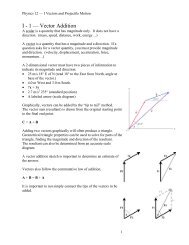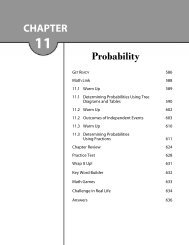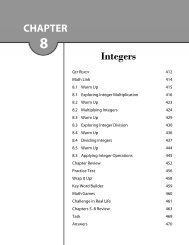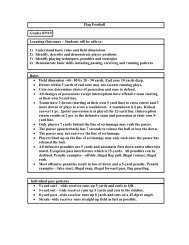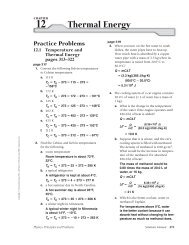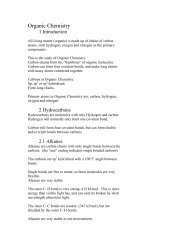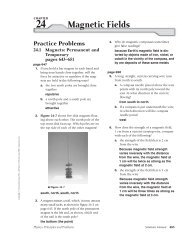Create successful ePaper yourself
Turn your PDF publications into a flip-book with our unique Google optimized e-Paper software.
<strong>IB</strong> <strong>Chem</strong>istry — 3 <strong>Atomic</strong> <strong>Theory</strong><br />
3.1 Hydrogen Spectrum<br />
Light is electromagnetic radiation that can be<br />
produced at different energy levels.<br />
High energy light has a short wavelength (λ) and<br />
a high frequency (ƒ, ν) (gamma rays, x-rays,<br />
ultraviolet). Low energy light has a long<br />
wavelength and a low frequency (infrared, radio<br />
waves).<br />
These levels come in a spectrum of wavelengths<br />
and frequencies.<br />
c = λ ƒ, c = speed of light<br />
Light emitted from a hot object has light at many<br />
different frequencies (depending of the motion<br />
of the atoms in the object).<br />
Light that has all the frequencies forms a continuous<br />
spectrum (all “colours” no gaps).<br />
It was found that light from an electrically excited atom did<br />
not form a continuous spectrum. It emitted a line spectrum.<br />
These lines are caused by the energy absorbed or emitted by<br />
an electron in an atom.<br />
An electron moving towards the nucleus emits<br />
energy (light), and electron moving away from<br />
the nucleus absorbs energy (light).<br />
The energies of these lines are specific to atoms and compounds.<br />
(This is how atoms in stars can be identified.)<br />
The energy is proportional to the frequency of the light<br />
E = hf<br />
Neils Bohr suggested that the specific energies could be explained<br />
if the electrons could only move to specific orbits around the atom<br />
and that these orbits had specific energies.<br />
This is the basis of the Bohr Model of the atom: First level can<br />
hold 2 electrons, the second and third levels can hold 8 electrons.<br />
(This model will become more complex)<br />
The transitions from 6-2, 5-2, 4-2, 3-2 happen to be in the visible<br />
spectrum.<br />
1
<strong>IB</strong> <strong>Chem</strong>istry — 3 <strong>Atomic</strong> <strong>Theory</strong><br />
The energy levels begin to converge as they get farther from the<br />
nucleus.<br />
An electron that falls from level 3 to level 1 will release a specific<br />
energy light (red)<br />
3 to 1 will be slightly more energy, (blue)<br />
4 to 1 will be slightly more energy, (violet)<br />
5 to 1 will be slightly more energy, (violet)<br />
6 to 1 will be slightly more, (near UV)<br />
7 to 1 and higher begin to converge.<br />
3.1 Hydrogen Spectrum<br />
Here is a partial spectrum of hydrogen:<br />
There will be one set of converging lines for level 1.<br />
There will be a different set of lines for the drop to each level.<br />
Changes between the higher levels of the hydrogen atom have very<br />
low energies.<br />
If an electron is given enough energy to go above the top level, it<br />
will leave the atom, forming an ion.<br />
Follow Up Problems 7.1, 2<br />
Problems 7.1, 2, 11, 18, 19a, 20, 22<br />
2
<strong>IB</strong> <strong>Chem</strong>istry — 3 <strong>Atomic</strong> <strong>Theory</strong><br />
3.2 Electrons Around Atoms<br />
Simplified Bohr Model:<br />
Electrons are in orbitals (shells) around the nucleus.<br />
First orbital can hold 2 electrons<br />
Second and third hold 8, fourth can hold 18.<br />
Bohr diagrams show the electrons:<br />
A more sophisticated model depends on quantum mechanics,<br />
primarily electrons behave like waves.<br />
To orbit the nucleus the electron must establish a standing wave.<br />
Standing waves can only exist in whole number steps.<br />
In an atom, the different standing waves form different orbitals.<br />
Here is a simple representation of the fifth harmonic around an<br />
atom. (top)<br />
The four and a half harmonic will cancel itself out. Electrons are<br />
not in the business of spontaneously disappearing.<br />
In a 3 dimensional atom, the actual shapes of the standing waves<br />
are quite complicated. As the waves get to higher harmonics, there<br />
are more possible shapes for the standing wave.<br />
For the first level of the atom (n = 1), the shape of the orbital<br />
(shell) is a sphere. The letter “s” is used to designate this orbital.<br />
3
<strong>IB</strong> <strong>Chem</strong>istry — 3 <strong>Atomic</strong> <strong>Theory</strong><br />
The second shell has a spherical orbital and three orbitals that have<br />
a dumbbell shape.<br />
They are designated 2s, 2px, 2py, and 2pz.<br />
You need to know the shapes of these orbitals.<br />
The third orbitals has 3s, 3p, and 3d shapes.<br />
There is also a 4f set:<br />
4
<strong>IB</strong> <strong>Chem</strong>istry — 3 <strong>Atomic</strong> <strong>Theory</strong><br />
Each sub-orbital can hold two electrons.<br />
The 1s can hold 2 electrons<br />
The 2s can hold 2 electrons, and the 2p can hold 6 electrons (two<br />
in each of px, py, pz).<br />
As orbitals get farther from the nucleus, they have a higher energy.<br />
The Aufbau principle shows us the order to fill the orbitals.<br />
The principle is that the lowest energy orbitals are filled first.<br />
Aufbau is German for “build up.”<br />
The energy levels of the different orbitals are given in the chart<br />
below. This is a complicated chart, but the order can be found on<br />
the periodic table.<br />
The order of filling these orbitals is given on the periodic table.<br />
Electrons are placed in the lowest orbitals first. Once they are full,<br />
then the next level is filled.<br />
Electrons behave like magnets. If two electrons are in the same<br />
sub-orbital one is placed “spin up” the other “spin down.”<br />
If three electrons are placed in the 2p orbitals, 1 is placed in each<br />
of px, py, and pz. All are placed in the same direction. (Hund’s<br />
Rule). The notation is 2p 3<br />
5
<strong>IB</strong> <strong>Chem</strong>istry — 3 <strong>Atomic</strong> <strong>Theory</strong><br />
Ex 1:<br />
Sketch the electron diagram and write the notation for:<br />
a) Li b) O<br />
c) Cl -<br />
e) Sn 2+ Now use shorthand for d) and e)<br />
The lowest energy arrangement of electrons will be the most<br />
stable.<br />
d) Fe<br />
Notice the energy increase after each of the noble gasses.<br />
A filled sub-orbital is more stable than a partially filled sub-orbital.<br />
To add electrons to a noble gas would cause a great increase in<br />
energy.<br />
This is why noble gasses are stable.<br />
Two exceptions to note are the ground states of chromium and<br />
copper.<br />
Cr is 4s 1 3d 5 .<br />
Cu is 4s 1 3d 10 .<br />
When an orbital is full or half full it gains some stability. Taking<br />
one electron from the 4s makes the 3d full or half full. Overall the<br />
atom is more stable this way.<br />
Follow Up Problems 8.2<br />
Problems 8.23, 27, 31, 35, 37, 39, 82 (no paramagnetism)<br />
6
<strong>IB</strong> <strong>Chem</strong>istry — 3 <strong>Atomic</strong> <strong>Theory</strong><br />
3.3 Periodic table Properties — Physical<br />
The properties we will examine are based on three principles (in<br />
general order of importance):<br />
1. Electrons in large orbits are farther from the nucleus and<br />
experience less attraction.<br />
2. More protons means more attraction.<br />
3. Electrons in the same sub-orbital repel each other.<br />
These factors repeat periodically as one moves along the periodic<br />
table. That is why the properties of elements also repeat<br />
periodically.<br />
<strong>Atomic</strong> size is a measure of the radius of the outer electrons in an<br />
atom.<br />
A trend is a general relationship that can have many exceptions.<br />
Each family (column) increases in size<br />
(larger orbital).<br />
Across each period, the size decreases<br />
from left to right because the number<br />
of protons is increasing (more<br />
attraction to the nucleus).<br />
There is also a notable jump in size for<br />
the start of the 4p and 5p orbitals.<br />
(Further down the table, the increase in<br />
protons has a smaller affect.)<br />
Ionic radii is also related to orbital size<br />
and number of protons.<br />
We will compare a set of ions that are<br />
isoelectric:<br />
N 3- , O 2- , F - , Ne, Na + , Mg 2+ , Al 3+<br />
These ions are all 1s 2 2s 2 3p 6 .<br />
What other ions combinations are isoelectric?<br />
The difference between these species is the number of protons.<br />
More protons means stronger attraction and a smaller radii.<br />
These values are all given on p. 7 of your data booklet. You<br />
will be asked to explain why these trends are present, not what<br />
the trends are.<br />
7
<strong>IB</strong> <strong>Chem</strong>istry — 3 <strong>Atomic</strong> <strong>Theory</strong><br />
Ionization energy is the<br />
energy needed to remove<br />
an electron from an atom.<br />
First ionization energy is<br />
the energy required to<br />
remove the first electron<br />
from an atom.<br />
This property is directly<br />
related to the attraction of<br />
the electrons to the nucleus.<br />
The trend should follow the<br />
same trend as the atomic<br />
size.<br />
What accounts for the variations in the trend between Li and Ne<br />
and between Na and Ar?<br />
Successive ionization energies (to remove more than one electron)<br />
also show evidence of periodic changes in electron configuration.<br />
The energy to remove another electron is always higher than the<br />
previous, be the increase in energy in not uniform.<br />
Explain the “jumps” after 2, 10, and 18 electrons.<br />
8
<strong>IB</strong> <strong>Chem</strong>istry — 3 <strong>Atomic</strong> <strong>Theory</strong><br />
Electronegativity is a<br />
measure of the attraction an<br />
atom has for a shared<br />
electron.<br />
This value will have the<br />
same trend as ionization<br />
energy.<br />
Electronegativity helps identify metals and non-metals. Metals<br />
generally form positive ions, and non-metals form negative ions.<br />
Semi-metals can form positive and negative ions.<br />
Metallic character is not a binary choice, it is a continuum.<br />
Metallic character is highest on the bottom left of the periodic<br />
table, and weakest (most non-metallic) on the top right of the table.<br />
Follow Up Problems 8.3, 4, 5, 8<br />
Problems 8. 46, 48, 53, 55, 57, 59, 86<br />
9.52, 57, 59<br />
9
<strong>IB</strong> <strong>Chem</strong>istry — 3 <strong>Atomic</strong> <strong>Theory</strong><br />
3.4 Periodic table Properties — <strong>Chem</strong>ical<br />
<strong>Chem</strong>ical properties provided the original clues to the periodic<br />
nature of the modern Periodic Table.<br />
Reactions involve the breaking and forming of bonds; this involves<br />
the electronic configuration of the valence (outer) electrons.<br />
Atoms that have similar electronic configurations (vertical<br />
families) will have similar chemical properties.<br />
The primary driver of many of the properties of elements is<br />
stability due to low potential energy.<br />
Atoms form ions to lower their energy (by filling, or partially<br />
filling, an outer shell of electrons).<br />
Atoms form ionic and covalent bonds to lower their potential<br />
energy.<br />
Group 1 alkali metals (family)<br />
These atoms all have one electron in the “s” orbital.<br />
To achieve a full outer shell, the atoms need to lose 1 electron<br />
(become a +1 ion).<br />
All the atoms in this family react similarly because they all will<br />
give one electron to become more stable.<br />
Alkali metals will react with water to give away an electron:<br />
Li(s) + H2O(l) " Li + (aq) + OH - (aq) + H2(g)<br />
Na(s) + H2O(l) " Na + (aq) + OH - (aq) + H2(g)<br />
K(s) + H2O(l) " K + (aq) + OH - (aq) + H2(g)<br />
This reaction will become more exothermic moving down the<br />
periodic table; less attraction for electrons means the electron will<br />
be given away easier.<br />
Halogens (F2, Cl2, Br2, I2, generically X2) need one electron to fill<br />
their outer shell.<br />
Halogens will react violenty with the alkali ions, for example:<br />
2 Na(s) + Cl2(g) " 2 NaCl(s)<br />
Which combination of alkali metal and halogen should react most<br />
violently? Why?<br />
10
<strong>IB</strong> <strong>Chem</strong>istry — 3 <strong>Atomic</strong> <strong>Theory</strong><br />
Halogens can be recognized by the precipitate they form with<br />
silver ions:<br />
Ag + (aq) + Cl - (aq) " AgCl(s)<br />
Ag + (aq) + Br - (aq) " AgBr(s)<br />
Ag + (aq) + I - (aq) " AgI(s)<br />
Halogens can also remove electrons from each other. Why do the<br />
following occur?<br />
Cl2(aq) + 2 Br – (aq) " 2 Cl - (aq) + Br2(aq)<br />
Cl2(aq) + 2 I – (aq) " 2 Cl - (aq) + I2(aq)<br />
Br2(aq) + 2 I – (aq) " 2 Br - (aq) + I2(aq)<br />
Across a period of the table (Na to Ar) there is a general trend from<br />
metallic elements to nonmetallic elements.<br />
This can be seen in the bonding of compounds across the table. A<br />
metal and a nonmetal form an ionic bond. Two nonmetals form a<br />
covalent bond.<br />
However, just as metallic nature is a continuum, ionic and covalent<br />
bonding does not have a clear separation.<br />
To determine ionic or covalent nature, compare the<br />
electronegativity of the elements in the bond. An<br />
arbitrary dividing line is a difference of 1.7 (less than<br />
1.7 is considered polar-covalent)<br />
Examining oxides and chlorides of the third period,<br />
describe the ionic or covalent nature of the bonds.<br />
Are these trends supported by the properties?<br />
Ionic compounds conduct electricity in molten form (mobile ions)<br />
Ionic compounds usually have a higher melting point than covalent<br />
compounds.<br />
For the reactions of these oxides and chlorides:<br />
• Ionic oxides form basic solutions, covalent oxides for acidic<br />
solutions (revisited in later units)<br />
• Ionic chlorides are very soluble in water<br />
• Covalent chlorides react slightly with water.<br />
Now, you need to be able to explain these trend. Later you will be<br />
expected to remember these reactions.<br />
Problems 14.7, 11, 17, 29, 48, 52, 54, 113<br />
11
<strong>IB</strong> <strong>Chem</strong>istry — 3 <strong>Atomic</strong> <strong>Theory</strong><br />
3.5 Transition Metals<br />
The transition metals are the groups of elements that are filling the<br />
“d” orbital.<br />
We will examine the elements filling the “3d” orbital.<br />
These elements have unique properties because of their “d” orbital.<br />
Scandium (Sc) and Zinc (Zn) are atypical of this group because Sc<br />
has only 1 electron in the “d” orbital, and Zn has a full “d” orbital.<br />
Ex 1:<br />
Write the electronic configuration for each element in the 3d<br />
transition element period.<br />
Atoms form ions because the ion’s electronic configuration is more<br />
stable (lower energy) than the atom’s.<br />
All these elements can form a +2 ions by losing both of the 4s 2<br />
electrons.<br />
What other ions could these elements be expected to form? (Refer<br />
to electron diagrams above.)<br />
A half full “d” orbital is also stable.<br />
Because transition metals can have various and variable charges,<br />
they are often good catalysts.<br />
• Iron in the Haber process<br />
• Vanadium(V) oxide in the production of sulfuric acid<br />
(contact process)<br />
• Nickel in the hydrogenation process<br />
• Manganese(IV)oxide in the decomposition of hydrogen<br />
peroxide.<br />
12
<strong>IB</strong> <strong>Chem</strong>istry — 3 <strong>Atomic</strong> <strong>Theory</strong><br />
Transition metals also form colourful complex ions.<br />
A complex ion is formed with ligands. A ligand is a compound<br />
with a pair of electrons that forms a weak covalent bond with the<br />
small transition metal ion. Both electrons in the bond come This from shows a complex ion<br />
one atom. It is called a coordinate covalent bond. with 6 ligands.<br />
These complexes are often very colourful.<br />
They are colourful because there are electron<br />
orbitals that are in the energy range that<br />
absorbs visible light.<br />
Some of the ligands are close to a “d” orbital.<br />
That orbital gains energy. The “d” orbitals are<br />
no longer degenerate. The new energy level<br />
change often corresponds to the energy of<br />
visible light.<br />
The ligands can be arranged in<br />
many different ways<br />
depending on the size and<br />
number of the ligands.<br />
Different ligands and different<br />
arrangements produce<br />
different properties.<br />
Follow Up Problems 23.1, 5<br />
Problems 23.4, 14, 16, 18<br />
Be able to explain why colours form for complex transition metal<br />
ions.<br />
13









